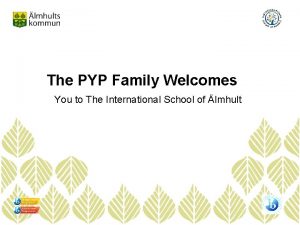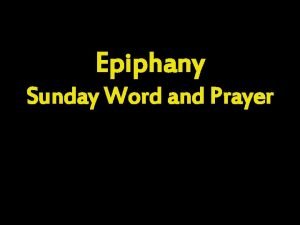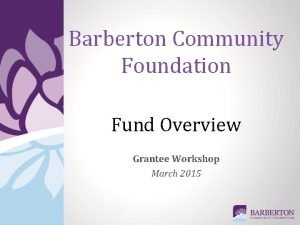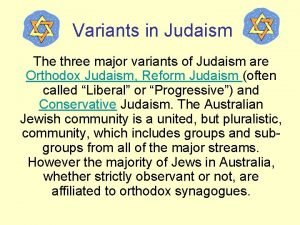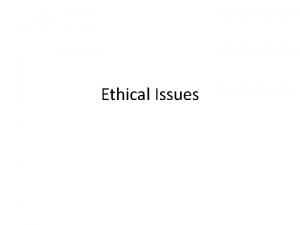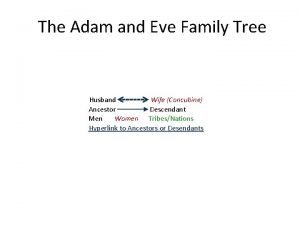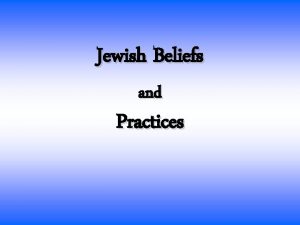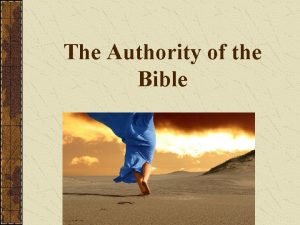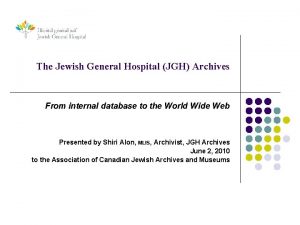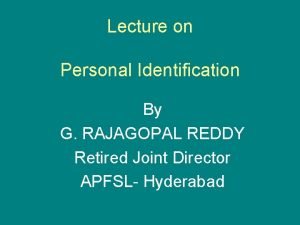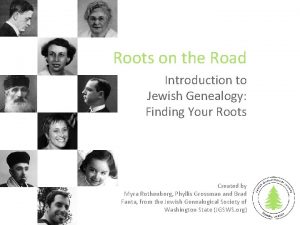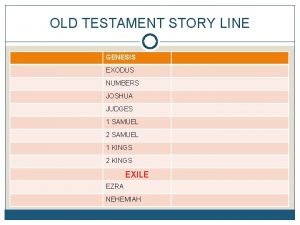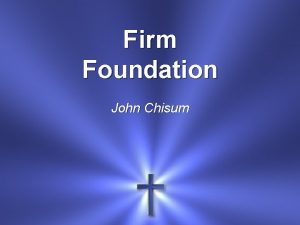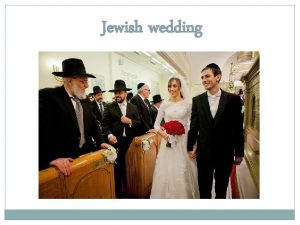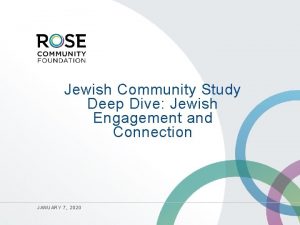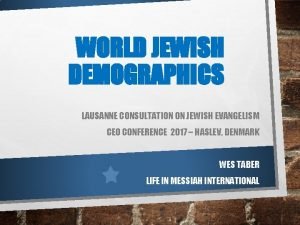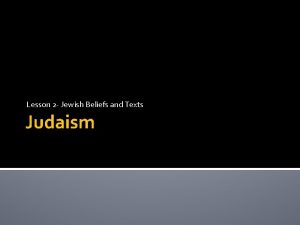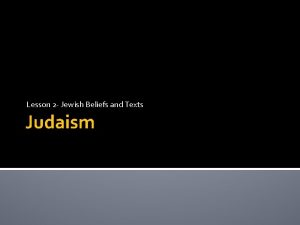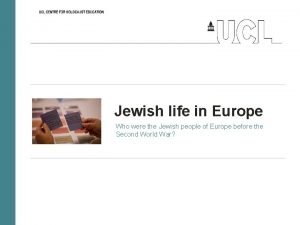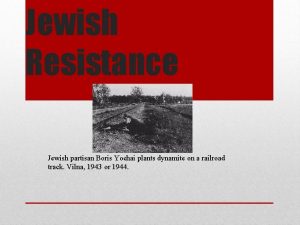THE JEWISH COMMUNITY FOUNDATION Welcomes you to The





















































































- Slides: 85

THE JEWISH COMMUNITY FOUNDATION Welcomes you to The Professional Development Seminar PAC 2018 1

2018 Professional Development Seminar Co-Chairs Anne-Marie Boucher Michael Frankel Mark Brender 2

US TAX REFORM IMPLICATIONS FOR CANADIANS Jeffrey Scheine Managing Director, Alchemy Capital Planning LLC June 13, 2018

US Tax Reform - 2018 • Major US tax legislation passed on December 22, 2017 • Legislation entitled “Tax Cuts and Jobs Act” (TCJA) • Contained significant changes to both domestic and international tax provisions for individuals and corporations • Most provisions applicable beginning January 1, 2018 • Many provisions sunset in 2025 4

US Estate and Gift Tax Changes General Rules – Prior Law • US citizen or resident – 40% estate tax based on fair market value of assets owned at time of death • Estate tax exemption of US$5. 6 million for 2017 • Basis step-up on death • Canadian resident subject to US estate tax on US sitused assets – US stocks – US real estate – Partnership interests where partnership carrying on US business • Treaty permits Canadian resident to claim a prorated estate tax exemption – ratio of value of US situs assets to worldwide assets 5

US Estate and Gift Tax Changes Change in Law • Increases the estate tax exemption to approximately US$11. 2 million for 2018 • Increased exemption sunsets in 2025 • Estate tax rate remained the same Impact on Canadian residents • Under Treaty, US estate tax should only apply if worldwide assets at death exceed the US$11. 2 million domestic exemption • Will need to file US estate tax return to claim treaty exemption • Sunset provision could reduce exemption after 2025 • Need to consider US rules to determine assets owned at time of death – Life insurance proceeds are included – RRSPs are included 6

Change in Tax Rates – Individuals and Corporations Changes • Maximum tax rate on ordinary income for individuals and trusts reduced from 39. 6% to 37% • Long-term capital gains rate (more than 1 -year) for individuals and trusts remains at 20% • New 20% deduction for certain business and real estate ordinary income derived by individuals and trusts directly or through pass-through entities – Does not apply to passive income and services income (above certain thresholds) • Reduction in corporate tax rate from 35% to 21% Impact to Canadians • Consider owning US real estate and US business assets through a corporation instead of individually to take advantage of lower US corporate tax rate • Need to also take into consideration state taxes since some states that do not have individual income taxes have corporate taxes (for example, Florida) • Review existing investments to see if restructuring is required – Both US and Canadian tax considerations will need to be addressed • Ownership of US assets by Canadian corporations avoids US estate tax risk 7

Modifications to CFC Rules – Prior Rules General Rules – Prior Law • • • A Canadian corporation will be a controlled foreign corporation (CFC) if more than 50% of its stock is owned by one or more US persons owning 10% or more of the voting stock. Family and entity attribution rules apply for purposes of determining stock ownership by US persons, however, no attribution from a non-resident alien. A “US Shareholder” is a US person or corporation owning 10% or more of the voting stock of a CFC. A US Shareholder is required to include in income currently its proportionate share of the CFC’s “Subpart F” income – Generally passive income (interest, dividends, capital gains and rents unless active) – If subpart F income is subject to Canadian tax at a rate equal to at least 90% of the maximum US corporate tax rate the “high-tax exemption” applies and no income inclusion required – Business income, rents from active real estate, US effectively connected income are not Subpart F income and no current income inclusion required If a US shareholder does not own stock for at least 30 days during the taxable year no income inclusion required under the CFC rules for such year (30 -day exception) 8

Classic Canadian Estate Freeze Structure Example of Impact of Change in CFC Rules: Canadian Parents 100% Redeemable Retractable Voting Preferred Shares Canadian Child 1/3 Non-Voting Common Shares US Child 1/3 Non-Voting Common Shares Canadian Holdco (Passive Investment Assets) 100% Canadian Opco (Active Canadian Business) 9

Modifications to CFC Rules Expanded Definition of US Shareholder • Effective January 1, 2018, definition of US Shareholder expanded to include US persons owning at least 10% of the vote or value of the CFC • Strategy of having Canadian parents retain voting power to avoid CFC status no longer works Elimination of 30 Day Rule • Liquidation during first 30 days of a CFC’s taxable year no longer avoids CFC income inclusion • Common planning technique of converting a Canadian corporation to an unlimited liability company (ULC) electing pass-through treatment following death no longer works 10

Modifications to CFC Rules (continued) Global Intangible Low Tax Income (“GILTI”) • Active income potentially subject to current income inclusion under the new GILTI rules • Despite description does not only apply to income from intangibles • In general, covers all income (other than Subpart F Income and US business income) of CFC which is greater than a 10% return on the adjusted basis of depreciable tangible property of the CFC • Could result in tax on undistributed active business income • US corporate shareholders get a 50% deduction • Election by a US shareholder under IRC § 962 may reduce the tax on GILTI income – US shareholder subject to tax on share of GILTI income at US corporates (21% rate) – Can claim a credit for underlying Canadian corporate tax paid by CFC – However, when income is distributed to US shareholder, it will included in income, thereby resulting in double taxation 11

Modifications to CFC Rules (continued) One-time Repatriation Tax • • Generally applicable to a US shareholder of a CFC having accumulated active earnings Must have been a US shareholder under prior law Similar election available to access Canadian corporate taxes paid, subject to limitations For calendar year CFCs with US individual shareholders the tax would be payable for the year ended December 31, 2017 Imposition of Tax • Include in income proportionate share of CFC’s undistributed earnings and profits (E&P) as at November 2, 2017 or December 31, 2017 (whichever is greater) • E&P will be taxed at a reduced rate of either 15. 5% or 8% (rate slightly higher for individuals) • Tax liability can be paid over a period of 8 years 12

Modifications to CFC Rules – Application to Canadian Corporations with US Shareholders Due to reduction in US corporate to 21% • More subpart F income may be eligible for high-tax kick-out – Canadian taxes in excess of 18. 9% will permit exemption to apply • IRC § 962 election with respect to GILTI income may significantly mitigate impact – Income taxed at corporate tax rate of 21% – Ability to claim a credit for Canadian taxes paid by CFC • Need to restructure Canadian corporations when shares are transferred by Canadian residents to US children upon death may be less urgent 13

Select Additional New Tax Provisions • Repeal recent court case holding gain on sale of partnership interest owning a US business is not subject to US tax • Anti-hybrid rule denying deductions for certain interest and royalty payments made by US taxpayers to related non-US persons • Net operating loss carryovers limited to 80% of taxable income • Additional limitations on interest deductions claims by US businesses (exception for businesses with US$25 million or less of revenue) 14

Contact Us : Jeff Scheine Alchemy Capital Planning LLC Managing Director 1221 Avenue of the Americas, 25 th Fl. New York, NY 10020 T: (212) 768 -5363 JScheine@Alchemy. CP. com 15

The New Private Company Paradigm Presented by: Sean Sprackett, CPA, CA Jacob Nataf, B. Sc. , B. C. L. /LL. B Date: June 13, 2018

Agenda 1. Introduction of the changes 2. Update on Income Splitting (TOSI Rules) 3. Update on Passive Investment Rules

1. Introduction of the changes

July 2017 - Targets of the Government • The Department of Finance consultation paper "Tax Planning Using Private Corporations" released on July 18, 2017, focused on changes in the following three key areas for Canadian Controlled Private Corporations (CCPCs): 1) Income Sprinkling 2) Holding Passive Investments Inside a Private Corporation 3) Converting Income into Capital Gains • The proposed changes were the most significant changes introduced in 45 years.

Introduction and Revised Rules • The government established a 75 -day consultation period with respect to the proposed measures; over 21, 000 submissions were received. • As a result, a series of responses were announced by the government during the week of October 16 th-20 th, 2017 these announcements included a repeal of both the draft legislation regarding the conversion of income into capital gains, and the changes proposed to the lifetime capital gains exemption. • On December 13, 2017, the Minister of Finance released new draft legislation surrounding income sprinkling and the Tax on Split Income (TOSI) rules. • On March 22, 2018, further revised legislation was released with small changes.

Private Company Tax Proposals • One win • One loss • One draw

Private Company Tax Proposals • Win – Capital Gains • The Federal Government backed away from the proposals that would have converted capital gains into dividends.

Private Company Tax Proposals • Loss – Tax on Split Income • The Federal Government is proceeding with the tax on split income measures.

Private Company Tax Proposals • Draw – Passive Investments (to be discussed later) • Significant improvement over the previous proposals. • Further clarity needed but easier to understand comply with and the CRA to administer.

2. Tax on Split Income (TOSI)

Revised TOSI Legislation • Not yet enacted, proposed to be effective January 1, 2018 – No significant changes expected – Service business exclusion might be relaxed • Introduced bright-line tests where TOSI would not apply • Many of the rules are complex and subject to interpretation • CRA also released its guidance on how they will apply TOSI rules for adults

Bright-line Tests Introduced – Excluded Amount TOSI will not apply: • Where a capital gain qualifies for the Capital Gains Deduction (QSBC or QFFP), including allocation from a trust • Where a business owner is age 65 or older and splits income with spouse (if it would be an excluded amount to him/her) • Income from property acquired as a result of the breakdown of marriage or common law partnership • Where shares are inherited from a deceased by Will, if income or gain on shares would not be TOSI to the deceased

Excluded Amount – QSBC Shares Trust Opco Facts: • Opco (QSBC) sold to arm’s length 3 rd party • Kids are beneficiaries and not involved in Opco • Trust realizes $5 M capital gain on disposition Conclusion: • QSBC shares Excluded Amount, even for minors • CGE claim not a requirement Government abandoned proposals to limit CGE claims the previous

Key Definitions • Specified Individual – applies to EVERYONE, no longer just to minors • Split Income – TOSI rules will apply to essentially any income, dividends and capital gains • Source Individual – Canadian resident and related to the specified individual Includes siblings • Related Business [bad person] – A business in which a Source Individual is an owner and is actively engaged on a regular basis related to earning income from the business • Excluded Business [good person] – A business in which a Specified Individual is actively engaged on a regular, continuous and substantial basis in the activities of the business A factual test

Excluded Business - Exemption Considerations § Document, with as much evidence as possible, time spent by family members § Past where possible § Present and future retain evidence § Issues in practice § Proving historical involvement § Multiple businesses full time but, does not meet 20 hours per week for any one business § Butterfly reorganizations siblings separate a business

Excluded Business vs Related Business MR MRS Service Co Manufactur e Co FMV fees Facts: • MR is actively engaged in the business of Service Co Excluded Business Good Person • Manufacture Co Related Business to MR Bad Person • Service Co charges Manufacture Co $300, 000 annually for FMV services • Service Co then pays Mr. its net profit of $200, 000 as a dividend • Dividend to Mr. from Service Co is considered to be an amount derived indirectly from Manufacture Co • Does TOSI apply to the dividend paid to MR?

Excluded Business and Excluded Amount Trust Hold. Co Opco Facts: • Beneficiaries: Husband, wife, 3 kids • Husband Child 1 (28 years old) active fulltime in Opco • Child 2 (20 years old) works part-time in Opco • Child 3 is 16 Conclusion: • Excluded Business for Husband Child 1; no TOSI on dividends from Trust • Child 2 IF, Actively Engaged, has an Excluded Business • TOSI applies for Wife until Husband is 65, then becomes an Excluded Amount for Wife • Child 3 is a minor, TOSI applies

Excluded Share – Exempt from TOSI Individual: 1. Is at least 25 years old by end of year 2. Owns 10% of the business (by votes and value) 3. Owns these shares directly The corporation: 1. Earns less than 90% of its income from the provision of services 2. All or substantially all of the business income is not derived directly or indirectly from a Related Business 3. It is not a professional corporation

Excluded Share – Disqualifiers Definition disqualifies the shares if: • The corporation earns less than 90% of its income from the provision of services • Not a Professional Corporation

Excluded Share - Problem Bro Sis Trucking Co Facts: • Bro and Sis started trucking business 4 years ago • Both Bro and Sis have been working full time • Operate 20 trucks with 50 employees • Bro gets sick and Sis wants to pay dividends to support him Conclusion: • TOSI applies to the dividend

Excluded Share - Uncertainty Related Business: “…actively engaged on a regular basis in the activities related to earning income from the business…” Excluded Business: “. . . actively engaged on a regular, continuous and substantial basis in the activities of the business…”

Reasonable Return – The Last Resort Exemption from Related Business TOSI Inclusion Requirement: Over the age of 24 Factors: • Relative contributions of the specified individual, and each source individual • Work performed • Property contributed • Risks assumed • All amounts that were paid (meaning historically) or that became payable • Such other factors as may be relevant

Planning for TOSI § Salaries § Consider CGE crystallizations if value available Gain to a minor will be taxed as an ineligible dividend under TOSI § Convert professional corporation to a regular CCPC if it is no longer active § Restructure to fit within “excluded shares” definition § TOSI vs Income Attribution § Some structures will need to wait until entrepreneur turns 65 § Marital breakdown § Stay tuned for more guidance from CRA and the courts!

3. Changes to Passive Investment Rules

Taxation of Investment Income of CCPCs • July 18, 2017 proposals included changes to how passive investments would be taxed inside a corporation Ø Very complex and riddled with issues Ø A lot of negative feedback • Modified by press release in October 2017 Ø Alluded to $50, 000 passive income threshold Ø Mentioned “grandfathering” of investments held • Budget 2018 proposal a positive change from initial proposals

New Small Business Limit Grind • Budget 2018 proposes to reduce the small business limit on a straight line basis for CCPCs having between $50, 000 and $150, 000 in investment income (annual test). • Will apply to taxation years that begin after 2018.

New Small Business Limit Grind • Reduced on a straight-line basis, with a $5 grind-down in the limit for every $1 in excess of $50, 000 of passive income.

New Small Business Limit Grind • Calculation of investment income would include investment income of any other associated corporations. • Annual test based on corporation's prior year’s adjusted aggregate investment income. • Reduction in a corporation’s business limit will be the greater of the reduction under this measure and the existing reduction based on taxable capital.

New Small Business Limit Grind • “Investment Income” will be measured by new concept “adjusted aggregate investment income” • Includes: Ø Ø Ø Interest, dividend and capital gains on investments Non-active rental income Capital gains (and losses) on disposition of property Dividends from non-connected corporations Income from savings in a non-exempt life insurance policy

New Small Business Limit Grind Excludes: Ø Capital gains (and losses) on disposition on property used in an active business in Canada by a CCPC or by a related CCPC Ø Capital gains on disposition of share of another CCPC that is connected with CCPC if certain tests met Ø Net capital losses carried over from other years Ø Dividends from connected corporations If the income from the passive investment kept being reinvested in the corporation, it may accelerate the negative tax impact attached to the grind of the CCPC small business deduction. N. B. There are no grandfather rules in the changes adopted.

Changes to Refundable Taxes on Investment Income Current Refundable Tax Regime: Ø Investment income taxed at roughly the highest personal tax rates in a corporation • 50. 37% in Quebec, 38. 33% on dividends Ø A portion of that tax is refundable • 30. 37% or the full 38. 33% on dividends Ø Tax is refunded at a rate of $38. 33 for every $100 of taxable dividends paid from the corporation to its shareholders

Changes to Refundable Taxes on Investment Income • Dividends paid by a corporation are either eligible or non-eligible. • Non-eligible dividends are generally paid from a corporation’s passive income and income taxed at the small business tax rate. • Eligible dividends are generally paid from a corporation’s income that has been subject to the general corporate income tax rate. • Prior to the changes, a corporation receives a refund of taxes paid on investment income regardless of whether the dividends paid are eligible or non-eligible.

Changes to Refundable Taxes on Investment Income • Budget 2018 proposes that there will be two pools of refundable dividend tax on hand ( « RDTOH » ), eligible and non-eligible, effective for the first taxation year beginning after 2018 • Existing RDTOH pool will be bifurcated into eligible RDTOH and non-eligible RDTOH Ø Eligible RDTOH will be deemed to be lesser of RDTOH balance at end of the last taxation year and 38 1/3% of the ending GRIP balance Ø Any remaining amount of the existing RDTOH pool will be deemed to be non-eligible RDTOH

Changes to Refundable Taxes on Investment Income • A refund of RDTOH will generally be available only in cases where a private corporation pays non-eligible dividends. − An exception will be provided in respect of RDTOH arising from eligible portfolio dividends received by a CCPC. • In such cases, eligible dividends are eligible to be paid to recover the RDTOH. • Eligible RDTOH will track refundable taxes paid under Part IV on eligible dividends. • Ordering rule provides that the payment of a non-eligible dividend by the corporation will generate a refund from its non-eligible RDTOH account before it obtains a refund from its eligible RDTOH account.

Questions?

Our Team Sean Sprackett Tax Partner & Tax Quebec Leader (514) 228 -7822 Sean. Sprackett@mnp. ca Jacob Nataf Tax Partner & Lawyer (514) 228 -7824 Jacob. Nataf@mnp. ca

The Philanthropic Conversation Jeremy Hampson CFP, CLU Senior Wealth Advisor Assante Wealth Management


Why Bring Up Philanthropy With Clients? Well …

History’s Largest Intergenerational Wealth Transfer Source: http: //benefaction. ca/new-trends-in-philanthropy/ $8 -10 trillion by 2050

Charitable Component of this Wealth Transfer? Estimated to be between $150 to $625 BILLION!! Shaw, Gillian. “Better to give than receive? Charities are hoping to share in the trillions to be inherited in coming years. " Vancouver Sun 7 April. 2008.

10 Reasons Why Advisors Should Discuss Philanthropy 1. More Satisfied Clients 2. Client Retention 3. Higher Net Worth Clients 4. Increase AUM 5. Competitive Moat 6. Increase Insurance Revenue 7. Deepen Client Relationship 8. Intergenerational Retention 9. More Referrals 10. Deeper Bond & Stronger Trust

#1 More Satisfied Clients with advisors guiding them on philanthropic planning 40% are more likely to be very satisfied with their advisors. Source: State Street Global Advisors – “The Heart of Wealth Management” 2017

#3 Higher Net Worth Clients 90% of self-made millionaires, or their partners, are involved in charitable activities. Source: AES Nation N=474 Self-Made Millionaires $5 -$50 Million Net Worth

#4 Increase AUM After making their plan, Charitable Estate Donors grew their net worth … 50% to 100% faster than others with the same initial wealth. Dr. Russell James – Professor, Charitable Planning at Texas Tech University $

#8 Intergenerational Retention 33% of heirs overall and 40% of millennial heirs are more likely to stay with an advisor if they also helped with the family philanthropy. 62% of investors agree it’s important to educate kids about family values and legacy. Source: State Street Global Advisors – “The Heart of Wealth Management” 2017

#9 More Referrals Advisors NOT working with the Philanthropic Affluent average: 1. 4 Client Referrals Advisors WORKING with the Philanthropic Affluent who facilitate planned gifts average: 3. 6 Client Referrals

#10 Deeper Bond & Stronger Trust “We highlight the humanity of wealth management when we help clients fulfill their own values through philanthropic giving. It’s where we provide returns to the portfolio along with returns to the soul. ” Brie Williams, Head of Practice Management at SSGA

Massive Disconnect How many advisors report having philanthropic conversations with clients. 91% How many clients reported having these conversations with their advisors. 13% CAGP – The Advisor/Client Conversation – “Talking About Philanthropy”

When? • • Early Often At strategic moments In the context of broader planning

Strategic moments • Sale of a business • Sale of real estate • Inheritance • Will and estate planning • Retirement • Year end tax planning

1 out of 5 Wealthy Donors cite Tax Advantages as one of their chief motivators

Legacy Motivated. . . 55% of wealthy donors wish to positively impact their communities. Source: BMO Financial Group Nov 2014

Ask Clients Open-Ended Questions • What are your values and beliefs? • Share with me those organizations that have had an impact on your education, health and cultural interest. • How do you want to handle succession planning? • How do you wish to be remembered? • Describe the charities that you’re actively involved with. • When do you typically make your donations? Throughout the year or in one lump sum? • How do you decide which charities to support? • What, if anything, frustrates you about the giving process? • Would you prefer to “give while you live” or at death?

Involuntary Philanthropy versus Voluntary Philanthropy

Webster’s Philanthropist phi·lan·thro·pist Benevolent supporter of human beings and human welfare.

Who is This? Taxpayer tax • payer Someone who gives up to one-quarter of their capital gains and one-half of their retirement income to support the general welfare of our country.

Would you donate your money this way? Source: Department of Finance Canada, (Fiscal Year Ended: March 31, 2014).

Charitable To Do List 1. Join a charitable committee (or two or three) 2. Join a board (or two or three) 3. Join The Canadian Association of Gift Planners Montreal Chapter www. cagp-acpdp. org/en/chapter/montreal 4. Get involved … don’t just show up! 5. Be authentic and passionate about the cause 6. Don’t expect business overnight (or at all)


For More information: JEREMY HAMPSON CFP, CLU SENIOR WEALTH ADVISOR ASSANTE CAPITAL MANAGEMENT LTD. 200 -2020 TRANS-CANADA HWY, DORVAL, QUEBEC, H 9 P 2 N 4 T: 514. 832. 5205 | TF: 800. 465. 2898| JHAMPSON@ASSANTE. COM www. kaplinhampson. com THANK YOU

DONATION OF PRIVATE COMPANY SHARES HOWARD BERISH FCPA, FCA The Jewish Community Foundation of Montreal 77

DEATH/DONATE/NO INSURANCE C. S. = chrystalized shares QSBC = shares not yet chrystalized but eligible for Capital Gain Exemption N. E. = not eligible for Capital Gain Exemption On Death - Final T 1 C. S. QSBC N. E. Proceeds of Disposition $800, 000 Adjusted Cost Base (800, 000) 0 0 Capital Gain 0 800, 000 Eligible For Capital Gain Exemption 0 (800, 000) 0 Capital Gain 0 0 800, 000 0 * 0 TAX ON CAPITAL GAIN $213, 000 *No AMT in year of death. 78

DEATH /DONATE/NO INSURANCE After Death - Estate C. S. QSBC N. E. If 164(6) To Cash Out TAX ON $800, 000 DEEMED DIVIDEND If Pipeline Planning FINAL TAX *$350000 $350, 000 N/A - $350, 000 $213, 000 0 0 $213, 000 If Sale To Arms Length Party FINAL TAX *Will have capital loss to carry back, but may not have gains to offset. 79

DEATH/DONATE/NO INSURANCE After Tax to Beneficiary -No Donation C. S. QSBC N. E. Proceeds of Disposition $800, 000 Taxes (350, 000) (213, 000) AFTER TAX TO BENEFICIARY $450, 000 $587, 000 Tax Savings on $800, 000 Donation $426, 000 After Tax With No Donation (450, 000) (587, 000) Cost of Donation $ (24, 000) (161, 000) Cost of Donation % 3% 3% 20% $100, 000 76, 000 Comparison Donation VS. No Donation Dividend Refund Assuming $100, 000 of RDTOH Individual/corporate Combined Benefit (cost) (161, 000) RESULT 1. VERY low after tax cost of donation 2. $800, 000 with charity to fund future donations 3. If corporation has RDTOH, redemption of shares by charity will generate dividend refund 80

DEATH/DONATE/INSURANCE Last To Die Male 65/ Female 60 C. S. QSBC N. E. Proceeds of Life Insurance $800, 000 Cost of Life Insurance (275, 000) NET BENEFIT OF LIFE INSURANCE $525, 000 81

DEATH/DONATE/INSURANCE SUMMARY C. S. Net Benefit of Life Insurance Net Cost of Donation (See Previous Slide) BENEFIT TO TAXPAYER QSBC N. E. $525, 000 (24, 000) (161, 000) $501, 000 $364, 000 RESULT 1. VERY low after tax cost of donation 2. $800, 000 with charity to fund future donation 3. If corporation has RDTOH, redemption of shares by charity will generate dividend refund 4. Create Capital Dividend Account 5. Substantial cash benefit to taxpayer 82

DONATE NOW/INSURANCE Present Value of Life Insurance $800, 000 for 30 years @ 3%. $330, 000 Present Value of Premiums $27, 500 for 10 years@3% (237, 000) Net Present Value Benefit $93, 000 C. S. QSBC N. E. Net Benefit to Life Insurance $93, 000 Net Cost of Donation (See Previous Slide) (24, 000) (161, 000) 69, 000 (68, 000) BENEFIT (COST) TO TAXPAYER RESULT 1. Immediate(or over 6 years) tax savings of $426, 000 2. During lifetime $800, 000 with charity to fund future donations 3. If corporation has RDTOH, redemption of shares by charity will generate dividend refund 4. Tax Savings from donation can fund insurance premiums 5. Create Capital Dividend Account on death 6. In long run, in pocket 7. Corporation out of pocket between time of donation and time of death 83

DONATE NOW/REDEEM LATER 1. Donate Retractable shares with cumulative dividend (Must be able to support Fair Market Value) 2. Pay dividend to charity each year to fund annual donations 3. Generate annual dividend refund 4. Corporation maintains use and control of funds; beneficial if can earn more than dividend paid to charity 5. Immediate (or over 6 years) tax savings of $426, 000 6. Can combine with life insurance 84

THANK YOU 85
 Jewish community foundation montreal
Jewish community foundation montreal Family welcomes you
Family welcomes you Http://www.freetranslation.com/
Http://www.freetranslation.com/ School welcomes you
School welcomes you School welcomes you
School welcomes you School welcomes you
School welcomes you Service sequence in restaurant
Service sequence in restaurant God welcomes us
God welcomes us Raft foundation vs pad foundation
Raft foundation vs pad foundation Foundation standard 1 academic foundation
Foundation standard 1 academic foundation Northamptonshire community foundation
Northamptonshire community foundation Barberton community foundation
Barberton community foundation Judaism variants
Judaism variants Hebrew
Hebrew Alan sugar computer
Alan sugar computer Yitzi genack
Yitzi genack Tribe of judah symbol
Tribe of judah symbol What are the two vocal music of israel
What are the two vocal music of israel Jewish chronic disease hospital study
Jewish chronic disease hospital study Three jewish feasts
Three jewish feasts Family tree adam and eve
Family tree adam and eve Samuel beckett haircut
Samuel beckett haircut Marc brown jewish
Marc brown jewish Judaism symbol
Judaism symbol Jewish leadership council
Jewish leadership council Judaism branches
Judaism branches Jewish place of worship
Jewish place of worship Hebrew festivals
Hebrew festivals Internal evidence of the bible
Internal evidence of the bible Jewish micrography
Jewish micrography 3 jewish artefacts
3 jewish artefacts Jewish buddha
Jewish buddha Jewish general hospital pharmacy
Jewish general hospital pharmacy Personal identification
Personal identification Jewish gen
Jewish gen Old testament jewish temple layout
Old testament jewish temple layout Misha dmitri tippens krushnic
Misha dmitri tippens krushnic Pseudoscientific ideas of race on jewish nation
Pseudoscientific ideas of race on jewish nation Jewish gen
Jewish gen Michael polansky jewish
Michael polansky jewish Nakuset jewish
Nakuset jewish Chappaqua jewish population
Chappaqua jewish population A group i belong to example
A group i belong to example Prepare to scale up in social mobilization
Prepare to scale up in social mobilization Integers and place value
Integers and place value Jesus youre my firm foundation
Jesus youre my firm foundation Error interval
Error interval Do you love the rain
Do you love the rain Good health is a choice agree or disagree
Good health is a choice agree or disagree If you think you can you can poem
If you think you can you can poem Tell me what you eat and i shall tell you what you are
Tell me what you eat and i shall tell you what you are Wherever you may lead i will follow
Wherever you may lead i will follow Hình ảnh bộ gõ cơ thể búng tay
Hình ảnh bộ gõ cơ thể búng tay Slidetodoc
Slidetodoc Bổ thể
Bổ thể Tỉ lệ cơ thể trẻ em
Tỉ lệ cơ thể trẻ em Voi kéo gỗ như thế nào
Voi kéo gỗ như thế nào Tư thế worm breton
Tư thế worm breton Alleluia hat len nguoi oi
Alleluia hat len nguoi oi Kể tên các môn thể thao
Kể tên các môn thể thao Thế nào là hệ số cao nhất
Thế nào là hệ số cao nhất Các châu lục và đại dương trên thế giới
Các châu lục và đại dương trên thế giới Công của trọng lực
Công của trọng lực Trời xanh đây là của chúng ta thể thơ
Trời xanh đây là của chúng ta thể thơ Mật thư tọa độ 5x5
Mật thư tọa độ 5x5 Làm thế nào để 102-1=99
Làm thế nào để 102-1=99 Phản ứng thế ankan
Phản ứng thế ankan Các châu lục và đại dương trên thế giới
Các châu lục và đại dương trên thế giới Thơ thất ngôn tứ tuyệt đường luật
Thơ thất ngôn tứ tuyệt đường luật Quá trình desamine hóa có thể tạo ra
Quá trình desamine hóa có thể tạo ra Một số thể thơ truyền thống
Một số thể thơ truyền thống Cái miệng xinh xinh thế chỉ nói điều hay thôi
Cái miệng xinh xinh thế chỉ nói điều hay thôi Vẽ hình chiếu vuông góc của vật thể sau
Vẽ hình chiếu vuông góc của vật thể sau Nguyên nhân của sự mỏi cơ sinh 8
Nguyên nhân của sự mỏi cơ sinh 8 đặc điểm cơ thể của người tối cổ
đặc điểm cơ thể của người tối cổ Thế nào là giọng cùng tên? *
Thế nào là giọng cùng tên? * Vẽ hình chiếu đứng bằng cạnh của vật thể
Vẽ hình chiếu đứng bằng cạnh của vật thể Phối cảnh
Phối cảnh Thẻ vin
Thẻ vin đại từ thay thế
đại từ thay thế điện thế nghỉ
điện thế nghỉ Tư thế ngồi viết
Tư thế ngồi viết Diễn thế sinh thái là
Diễn thế sinh thái là Các loại đột biến cấu trúc nhiễm sắc thể
Các loại đột biến cấu trúc nhiễm sắc thể Thế nào là số nguyên tố
Thế nào là số nguyên tố Tư thế ngồi viết
Tư thế ngồi viết

